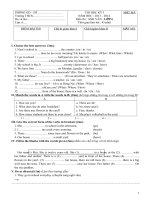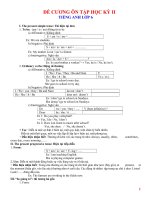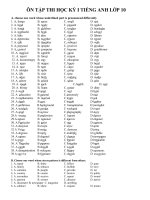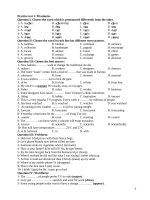Ôn thi HSGQG tiếng Anh 2
Bạn đang xem bản rút gọn của tài liệu. Xem và tải ngay bản đầy đủ của tài liệu tại đây (89.08 KB, 11 trang )
PRACTICE TEST 5
LEXICO-GRAMMAR
1. The boy who was caught _____ candy or little toys many times but was never punished by his mother
grew up to be a thief.
A snitching
B burgling
C ransacking
D pilfering
2. Some students attempted to _____ the teacher while the others prepared the surprise birthday party
for her.
A stall
B haul
C swathe
D wane
3. Adam has no right to _____ his position on how much our class should donate, that is our internal
affair.
A hammer out
B screen out
C stake out
D take out
4. Getting into the third round of 2022 World Cup is a real _____ for the Vietnam national team.
A coup
B deed
C epic
D crusade
5. The four-week circuit _____ will come into force tomorrow with the closure of pubs, bars,
restaurants and non-essential shops.
A breaker
B spell
C respite
D span
6. The old owners of the homestay are extremely hospitable and whenever I travel to Dalat, I know
there will always be a _____ welcome awaiting me.
A. princely
B. heart-rending
C. profound
D. abstruse
7. School ends at 5 so my only choice is to _____ a chocolate bar on my way to my extra Math class,
which starts only 10’ later.
A. rattle through
B. scarf down
C. romp through
D. scuff down
8. Having performed excellently in the Quidditch match, Ron _____ his moment of glory, holding the
trophy up to the crowd.
A blazed up
B clocked up
C plunged in
D basked in
9. The image of peace and prosperity appearing on TV is rather _____ and does not reflect the actual
situation of the city.
A factious
B factitive
C factive
D factional
10. Of course we all love a better quality fridge, but for a low-income family like us, it’s better to cut
your _____ according to your cloth.
A cloak
B coat
C clothes
D gloves
11. There are many problems that laws don’t intervene and it totally rests with the moral _____ of each
individual to prevent wrongdoings.
A fibre
B anchor
C rigidity
D latitude
12. My boyfriend refused to climb up the treetop with me because he doesn’t have a _____ for heights.
A heart
B head
C soul
D foot
13. I have received many warnings about my studies recently and was threatened to be grounded by
my parents, another low grade this time will be _____ to me.
A the last straw
B the final nail in the coffin
C the parting shot
D the drop in the bucket
14. I thought willpower was enough to take me to the finish line, but when my muscles got sore and
my body was exhausted, I knew I had _____.
A hit the deck
B hit the sack
C hit the wall
D hit the roof
15. He was brought up in an educated family but hanging out with the street children has turned him
into a(n) _____ young man with bad manners.
A uncouth
B profane
C impious
D stoic
1
Word form
1. The police had been on _____STAKE-OUT_____ in our neighborhood for a week to collect evidence
before they arrested the drug dealer. (STAKE)
2. Meeting the first girl he loved after 8 years, old feelings ____RESURFACED____ in the heart of the
married man. (FACE)
3. I later put my shoes back on because shells and gravel made walking ____BAREFOOT____ on the
beach uncomfortable for me. (FOOT)
4. Although the technique seems simple compared to those of modern days, paper produced by Cai
Lun was considered ______GROUND-BREAKING___ at that time. (GROUND)
5. The German recycling system provides a _____BENCHMARK____ against which schemes in other
nations can be measured. (BENCH)
READING
Part 1. For questions 1-13, read the following passage and do the tasks that follow.
CARS THAT CAN DRIVE THEMSELVES
A. The idea of the self-driving car dates back to before the Second World War. Visitors to General
Motors' 'Futurama' at the 1939 World Fair in New York were shown a vision of the future in 1960, in
which radio-controlled automobiles would zip along perfectly safe highways. In the 1950s, General
Motors and the Radio Corporation of America began experimenting with such a system, digging radiotransmitting cables into roads at a cost of around $100,000 per mile.
B. The system worked. In 1958, a Chevrolet impala made it round a special course 'without the
driver's hands on the steering wheel' but it joined the list of other expensive automated dreams. The
first real breakthroughs for self-driving cars took place in the late 1980s, in the £800m Eureka
Promethesus Project, led by Ernst Dickmanns of the Bundeswehr University Munich, a pioneer of
computer vision. Using just four black and white cameras, Dickmanns's cars managed two road trips
of more than 1,000 kilometres through Europe in 1994 and 1995, driving without human intervention
95% of the time. Automated cars have made huge leaps and bounds in recent years. Starting in 2004,
Darpa, the high-tech research wing of the US military, ran a series of competitions for driverless
vehicles. The winning team was hired by Google, and for years the technology company ran a fleet of
automated cars around the highways of California. So far the cars have clocked up 200,000 miles and
have been involved in one minor human-caused accident. Google is not on its own. Other car
manufacturers also have some kind of automated car in the works, with research and testing also
going on in the UK and Germany.
C. Most driverless cars share the same 'Velodyne' laser system on their roofs. 64 spinning lasers
provide a constant, 3D view of the environment 40 metres around the car, while radars on the
bumpers and a rear-view camera also feed in information. The data is sorted by algorithms that
distinguish between cars, pedestrians, plastic bags and cats, and tell the car what to do. Automated
cars are programmed to be model drivers: they stop when pedestrians step onto the road; they give
way when they should; they stay out of other cars' blindspots and nudge forward when other cars
should be letting them through.
D. Across the world, 1.2 million people are killed or injured on the roads each year with human error
to blame 90% of the time. 'It's amazing to me that we let humans drive cars,' says Eric Schmidt, the
executive director of Google. Paul Newman, a robotics engineer at Oxford University, says it is only a
matter of time before we hand over the wheel. 'It's crazy to imagine that in ten to twenty years we'll
still have to sit behind a wheel, concentrating hard, not falling asleep and not running over people' , he
2
says. Computer-controlled cars offer the benefits of safety, fuel efficiency and speed. Roads full of
automated cars, all communicating with one another, will see vehicles going bumper-to-bumper at
70mph, eliminating traffic jams.
E. In spite of the encouraging pace of development, however, enormous hurdles still remain, notably
how to engineer human common sense. 'Imagine a situation where a box falls onto the road in front of
you,' says John Leonard, a mechanical engineering professor at the Massachusetts Institute of
Technology. 'The system needs to make a split-second decision to either go straight through it or to
swerve left or right - which might have worse consequences than just going forward'. Other challenges
include recognising the weaknesses of automated cars: how do their sensors respond to glare, poor
weather, or damage?
F. However, no matter how good, their guidance systems are, self-driven cars will still have accidents.
In which case, who will be responsible - the car manufacturer, the software developer or the human
driver - for failing to override the computer at the critical moment? But will the cars even have people
on board? One of the attractions, surely, will be in ordering them to come and pick us up: in which
case will it be empty car A, or car B with driver, which is to blame for a driving mistake? In whatever
form they emerge, automated cars will require the greatest overhaul of the law of the roads since the
rise of the automobile in the first half of the 20th century.
G. It seems unlikely, at least for the time being, that drivers will hand over their car keys. A lot of
people actually like to drive and hate being passengers. More likely we will see a continuation of the
gradual automation of cars that have been under way for two decades, during which automatic lanekeeping, cruise control and parking aids have been gratefully taken up. A new Volvo, for example, now
maintains safe distances in heavy traffic without human intervention, and Nissan is working on
software that anticipates a driver's next move, adjusting the car ahead of time. Piece by piece, radars,
lasers, car to car communication, and the warning of dangers ahead will be added as well, slowly
easing the wheel out of our hands.
Questions 1-7
The reading passage has seven paragraphs A-G. Choose the correct heading for each paragraph
from the list of headings below. Write the correct numbers i-x in boxes 1-7.
List of headings
i The legal implications of automated driving
ii The limitations of the automated car
iii Towards a partial public acceptance of automated cars
iv The long dream of the automated car
v The downward trend in the demand for automated cars
vi The definition of an automated car
vii The current financial cost of developing automated car technology
viii The rationale behind the concept of the automated car
ix Common technological features of automated cars
x Remarkable success of automated cars on the road
Your answers
1. iv
2. x
3. ix
4. viii
5. ii
3
6. i
7. iii
Question 8-13
Do the following statements agree with the information given in the Reading Passage?
In boxes 8-13, write
TRUE
if the statement agrees with the information.
FALSE
if the statement contradicts the information.
NOT GIVEN if there is no information on this.
8. Google’s driverless cars have recorded no technical hitches since their deployment.
9. It is claimed that human drivers inevitably cede their role to automated cars.
10. The technology could allow cars to drive with a greater degree of safety when they are closer
together.
11. Common sense reasoning would be a nice-to-have for self-driving cars but is not truly required.
12. The limited capacity to cope with emergencies is a major setback of autonomous cars.
13. The upgrade of driverless cars would guarantee no car crashes occurring in the future.
Your answers.
8. NG
9. T
10. NG
11. T
12. NG
13. T
Part 2. For questions 14-23, read an extract from an article and choose the answer A, B, C or D
that fits best according to the text. Write your answers in the corresponding numbered boxes
provided.
TEENAGE BRAINS
Journalist Martin Baines talks to neuroscientist Professor Sarah-Jayne Blakemore about the development
of the brain during adolescence.
Until I read Inventing Ourselves by Professor Sarah-Jayne Blakemore, I'd always assumed that what
we think of as teenage behaviour is largely an invention of contemporary western society. I hadn't
imagined, for example, that 15-year-olds in the Kalahari Desert also complain about having to get up
early — but they do. It was for people like me — there are lots of us — that Blakemore wrote her book
explaining the science of everything from why teenagers can't get out of bed in the morning to why
they sometimes appear to be irresponsible narcissists. `We demonise teenagers more than any other
section of society,' she told me. 'And it's not right. They're going through an essential stage of their
development. Most adults don't realise this.'
This is arguably inevitable. Blakemore says that until 20 years ago, it was assumed that teenage
behaviour was largely down to hormonal changes in puberty and that children's brains were more or
less fully developed. The findings of brain scans and psychological experiments have now revealed
that the reality is very different, however. In fact, the brain continues to change all through the
teenage years and well into adulthood, and important neurodevelopmental processes enable it to be
moulded by the environment. So adolescence is a critical period of neurological change, much of
which is responsible for adolescent behaviour.
Blakemore quotes from a teenager's diary dated 20 July 1969: 'I went to arts centre (by myself!) in
yellow cords and blouse. Ian was there but didn't speak to me. Got a rhyme put in my handbag from
someone who's apparently got a crush on me. It's Nicholas, I think. UGH. Man landed on the moon.'
4
This may look like amazing — even jaw-dropping — self-absorption. But Blakemore says it's
essential neurological development, because the biological function of adolescence, today and in the
past, is the creation of a sense of self. Teens achieve this through creating new allegiances,
independent of their parents — which is why their friendships suddenly become extremely important.
What is known on social media as FOMO — fear of missing out — may look like an irrational sense of
priorities if it means skipping revision to attend a run-of-the-mill get-together, but at that age,
nothing matters more than peer approval.
Blakemore designed an experiment to explore this. Adolescents were asked to play an online ball
game, with what they believed to be two other players of their own age. In fact, the game was with a
computer programmed to ignore the human participants; these found themselves watching the ball
being passed between two players on the screen who chose not to include them. She repeated the
experiment with adults, and found that, while the game lowered the mood and increased the anxiety
levels of all participants, the effect was dramatically greater for the teenagers.
In her book, Blakemore also discusses how the neurologically driven preoccupation with peer
approval underlies adolescent risk-taking and acute self-consciousness, and how it determines
adolescent sleep patterns. It's fascinating, and I'm curious about the implications. What could be done
to accommodate the changes adolescents go through?
Blakemore suggests we might harness the power of peer pressure by getting adolescents to run
educational campaigns — for example, on healthy eating. She also mentions schools which have
altered their start times to fit in with teenage sleep patterns, though she points out there may be
practical issues about implementing this on a wider scale. But generally, she's wary about putting
forward concrete solutions. This seems regrettable, but she insists she's a scientist rather than a
consultant. She doesn't even like to be asked for parenting advice, although she admits her work does
inform her own parenting. When she recently visited her teenage son's school, he asked her to
pretend not to know him. 'I could've been so offended by that. But I thought: "That's absolutely
normal."'
[ ] One thing that makes Blakemore's empathy and affection for teenagers so striking is its rarity.
[ ] But why does she think so many other adults feel differently? [ ] She often thinks about why we
find it hilarious to 'take the mickey out of teenagers'. [ ] She points out that there are whole
comedy shows mocking their behaviour. She wonders if adults do it to cope with their rejection;
small children obey adults and want to be with them, but teenagers, through necessity, look for
independence, and the older generations feel hurt about this. They resent adolescents' desire to
rebel and their sense of embarrassment when they're with parents. 'Our way of dealing with these
changes is to sneer at them.'
14. What is the writer doing in the first paragraph?
A outlining how he feels about the way teenagers are generally perceived
B giving his reasons for writing a profile of Professor Blakemore
C pointing out international variations in teenage behaviour
D acknowledging his relative ignorance about teenagers
5
15. The writer suggests that the way teenage behaviour is commonly regarded is unsurprising
because
A behavioural development is a complex subject.
B significant progress in relevant areas of study is relatively recent.
C people's outlook on life is partly determined by neurological factors.
D differences between generations will always cause misunderstanding.
16. What does the writer suggest is `jaw-dropping' about the teenager's diary entry?
A the strong desire for independence that comes across
B the similarity with what young people talk about today
C the negative comments about two acquaintances
D the focus on personal rather than wider events
17. The experiment described in the fourth paragraph was designed to provide evidence of
A how competitive teenagers tend to be.
B how easily teenagers can be deceived.
C how sensitive teenagers are to social exclusion.
D how immersed teenagers can become in video games.
18. In the sixth paragraph, the writer expresses
A disappointment at Blakemore's reluctance to advocate specific policies.
B enthusiasm for the idea of giving teenagers more responsibility.
C amusement at Blakemore's difficulties with her own children.
D doubt regarding the feasibility of changing school hours.
19. Which words in the final paragraph echo the phrase ‘take the mickey out of’?
A cope with
B feel hurt about
C resent
D sneer at
20. Look at the four squares [■] that indicate where the following sentence could be added to] that indicate where the following sentence could be added to
the passage.
'Yes, I'm a champion of them,' she agrees.
Where would the sentence best fit?
A. First square
B. Second square
C. Third square
D. Fourth square
21. What does the word “It” in paragraph 1 refer to?
A. teenage behaviour
B. book
C. invention
6
D. Kalahari Desert
22. The word ‘demonise’ in paragraph 1 is closest in meaning to:
A. vilify
B. eulogize
C. overlook
D. notice
23. The word ‘run-of-the-mill’ in paragraph 3 is closest in meaning to:
A. distinguished
B. ordinary
C. tedious
D. provocative
Your answers
14.
15.
16.
17.
18.
19.
20.
21.
22.
23.
Part 3. You are going to read an extract from an article. Seven paragraphs have been removed
from the extract. Choose from paragraphs A—H the one which fits each gap (24-30). There is
one extra paragraph which you do not need to use.
MY DIGITAL DETOX
Spending a weekend without access to communications technology was an eye-opener.
We were brushing through wet grass in the early morning when we saw it - a flash of white drifting
behind a small patch of trees, backlit by the sun. Crouching down next to Artley, our twenty-onemonth-old son, my partner Will and I watched the unmistakable shape of a barn owl until it
disappeared into the wood. The look on Artley’s face was part of a brief moment of magic, the kind of
memory that we live for. Ordinarily, my next thought would have been to pull out my phone, take a
photo or video and send a message. Connecting is something I do unconsciously now, and sharing
such moments has become second nature.
24.
F
That weekend, however, the three of us were, by our own choice, offline. We were camping at a rural
site called Swallowtail Hill in southern England, which offers visitors the option of leaving all their
electronic devices in the safe keeping of the owner for the duration of their stay - a kind of digital
detox, you might say. We had been inspired by William Powers' book Hamlet’s BlackBerry, an
imaginative and thoughtful work that explores reactions to new technologies throughout history and
the lessons we should have learnt from them. Blessed with two days of good weather and some
delicious local food, I barely noticed I wasn’t online.
25.
G
Take equal responsibility for our digital obsession - magnetically drawn, as I am, to any screen that
can feed my addiction. Nonetheless, any objections of mine to this specific vice are usually swiftly
defended by an explanation of the importance of dealing with whatever it is now, though it never
seems anything that couldn’t wait half an hour. Suddenly, however, we had his full attention - well
almost. There was a moment when he was distracted by a buzzing sensation and automatically
reached for his phone, before realising it was a bee.
7
26.
B
By breaking away from my connected life, however, I came to appreciate just how much it had
permeated my way of being. So-called ‘early adopters', the heavy technology users who throw
themselves at every new device and service, will admit to an uncontrollable impulse to check their
email accounts or social networking sites. Researchers have called this 'variable interval
reinforcement schedule'. Such people have in effect been drawn into digital message addiction
because the most exciting rewards are unpredictable.
27.
H
A study by the University of California concluded that such constant multi-tasking gradually erodes
short-term memory. It also discovered that interruptions to any task requiring concentration are a
massive problem, as it takes us much longer to get back into them than it does to deal with the
interruption itself.
28.
C
In other words, what was once exterior and faraway is now easily accessible and this carries a sense
of obligation or duty. He sees the feeling that we should be reaching out, or be available to be reached
out to as tied to the self-affirmation that the internet, and all that goes with it, provides us with.
29.
D
One practical suggestion, for example, is to use paper as a more efficient way of organising our
thoughts. The theory of ‘embodied interaction' asserts that physical objects free our minds to think
because our hands and fingers can do much of the work, unlike screens where our brains are
constantly in demand.
30.
E
As we left Swallowtail Hill, we seemed to have achieved that. The real work was just starting,
however, trying to put this and other ideas into regular practice in an attempt to balance work and
home life. Powers also talks about ‘vanishing family trick’, where a seemingly sociable family
gradually dissolves away to screens in different corners of the house. It's clearly a situation to be
avoided. Our digital detox had been something of a wake-up call. And guess what? When the owner
handed back our phones, we didn't have a missed call or message between us.
The misssing paragraphs
A. At home, those concerns about my digital addiction are most acute when I catch my son looking at
me while I'm checking a screen. It's reinforcing how much more important the screen is than him, as if
I'm teaching him that obeying these machines is what he needs to do.
B. In truth, he wasn't at one in such lapses. Without our hand-held devices, neither of us had much
idea what the time was. Then, I reached for mine when I wondered about local shopping facilities and
8
whether it is normal to see a barn owl during the day. And the magical moment when Artley was being
read his bedtime story in front of an open fire, I've had to try and commit to my own fallible memory.
C. For those of us compelled to check email every few minutes, that finding accounts for those days
which seem to pass so quickly with so little getting done. And this is part of a wider trend. 'The more
we connect, the more our thoughts lean outward,’ Powers writes. ‘There's a preoccupation with
what’s going on “out there" in the bustling otherworld, rather than “in here" with yourself and those
right around you.’
D. Like me, he is a true believer in the value and potential of digital technologies. He concludes,
however, that we need to find the discipline to restore control by reintroducing a little
disconnectedness.
E. More radical still is the idea of banning the internet at weekends on the grounds that being away
from it on a regular basis allows us to grasp its utility and value more fully, Hopefully, it also brings
about a shift to a slower, less restless way of thinking, where you can just be in one place, doing one
particular thing, and enjoy it.
F. The meaningful and the mundane have thus merged into one, all dutifully and habitually recorded my enjoyment split between that technological impulse and the more delicate human need to be in the
moment. This is how we live these days.
G. What did strike me though was the change in Will’s behaviour. If my worst habit is incessant
messaging, his is allowing his phone to take precedence over everything else. Country walks, dinner,
bathing our son - no moment is safe from the seemingly irresistible ringing, vibrating, nagging phone,
that demands - and wins - his attention when he should be enjoying the moment with us.
H. What’s more, the hustle they develop as they struggle to keep up with the pace of all that incoming
information has produced a restless, anxious way of engaging with the world. Desperate for efficiency,
this seeps into people's physical lives. Perhaps that's why I feel compelled to tidy while on the phone,
to fold the washing while brushing my teeth, and no single job has my undivided attention.
Your answers
24.
25.
26.
27.
28.
29.
30.
Part 4. The passage below consists of four sections marked A-D. For questions 31-40, read the
passage and do the task that follows. Write your answers (A-D) in the corresponding
numbered boxes provided.
IS CHARITY AS IMPORTANT AS WE ARE TOLD IT IS?
A Mark
No matter how convinced we may be that we are members of a caring, responsible society that has a
well-established safety net, the fact remains that there are still plenty of people who fall through the
cracks. Too many of us sit back, supposedly safe in the knowledge that the authorities are living up to
the duty of care they have for the most vulnerable members of society. In fact, even a not particularly
rigorous examination of the trials and tribulations faced by some people will reveal plenty of
situations in which they are enduring difficulties that are not even officially acknowledged, never
mind addressed. The nub of the matter is that, in too many cases, people only become aware of some
9
of the extreme difficulties faced by fellow citizens when they themselves become victims of the same
circumstances - and in the process discover that there is actually no official they can turn to for help.
B Alice
Charities are organisations set up in an attempt to offer a lifeline to those who, often through no fault
of their own, find themselves in extremely difficult circumstances for which the state can't or won't
give them any meaningful or effective assistance. In the same way, we must consider situations where
we, personally, could step in to give a hand. For the fortunate amongst us, when we consider our own
lives, we will likely become aware of the extent to which our family members and other people
close to us help us to overcome our problems. Sadly, a lot of people are not blessed with caring
relatives or friends, and this is where we ought to consider how we can be good neighbours. Of course,
we can't do much in this regard if we have little contact with our neighbours and even less awareness
of anything going on in their lives. However, there are plenty of charities that do try to help people
and could do a better job if they had more assistance or support from us. I believe at we can provide
some useful help to people in our communities if we make the effort to contact a charity that interests
us and offer our support in whatever way we can.
C Julian
In an ideal world, far fewer people would be reliant on charities. The sad reality reflects poorly on
society, particularly as regards the extent to which the authorities are able to relieve the burdens
which some people end up facing alone. I know of regrettable instances where children are given
detention at school for 'offences' that arise simply because they have to take time out to look after
seriously ill or disabled parents. As a result of these detentions, they then have even less time to
support their parents. Obviously, this creates a vicious circle that will lead the child to missing out on
a significant part of their education and could quite possibly have even worse consequences. As a
result of finding out about someone in such circumstances, I am now shouldering some of that child's
burden, but I have not yet found a charity that I can turn to for more help.
D Beth
On the whole, I think we're fairly spoilt compared with people who live in certain other parts of the
world. We live in a democracy which has operated a welfare state for several generations. I appreciate
that the budget doesn't always allow enough funding to ensure that everyone gets adequate support,
but we also have a long history of philanthropy. Personally, I am lucky to have a great network of
friends and relatives whom I can turn to for assistance, but I know that lots of people must get by
without this advantage. To tell the truth, there are quite a few charities that I don't consider to be
particularly important or useful, but that is none of my concern, since I'm not forced to give them
donations. However, there are others that I thoroughly approve of, and I actually volunteer for one of
them in my free time.
Which person gives each of these opinions about charities?
Which person mentions
Answers
10
31. It's difficult to help the people around us if we don't know what problems they are
facing.
B
32. I value the work of some charitable organizations more highly than that of others.
D
33. Often, people only come to understand others' problems through personal
experience.
A
34. It would be preferable if the work of charities was not so necessary.
C
35. It is understandable why the public sector can't take on more responsibility.
D
36. Quite often an assumption people make results in them being less likely to take the
initiative to help people.
A
37. It is likely that problems not receiving adequate attention will be exacerbated.
C
38. We can all help charities to work more effectively.
B
39. Someone's personal circumstances should be considered before they are punished
for something that they felt they had to do.
B
40. It isn't hard to pinpoint examples of people with hardships who are receiving no help
from the authorities.
A
11









